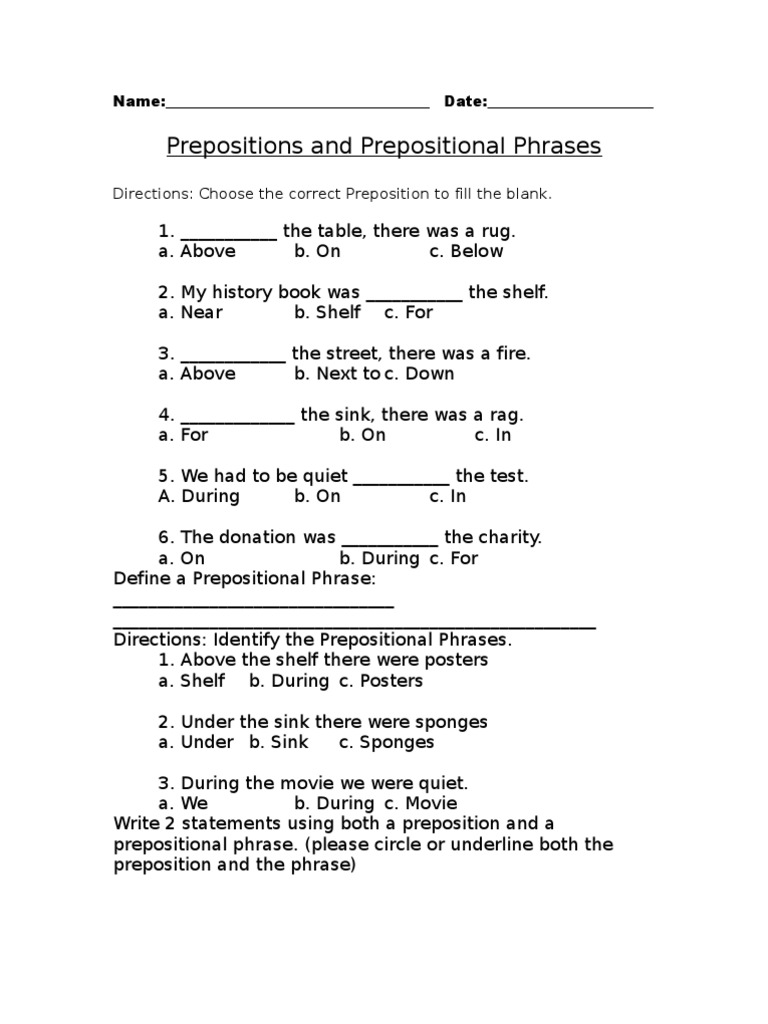
Mastering Grammar with Prepositional Phrases Worksheets: A Comprehensive Guide
English grammar, with its intricate rules and nuanced structures, can often feel like a complex puzzle. Among its many components, prepositional phrases stand out as versatile elements that add depth, detail, and clarity to sentences. They are fundamental building blocks that help paint vivid pictures and convey precise information. However, mastering their identification and correct usage can be a significant hurdle for many learners. This is where Prepositional phrases worksheets become an indispensable tool. They offer structured practice, reinforce learning, and provide a clear path to grammatical proficiency.
This comprehensive guide will delve into what prepositional phrases are, why they are crucial, the various types of Prepositional phrases worksheets available, their benefits, and how to effectively integrate them into learning and teaching strategies.
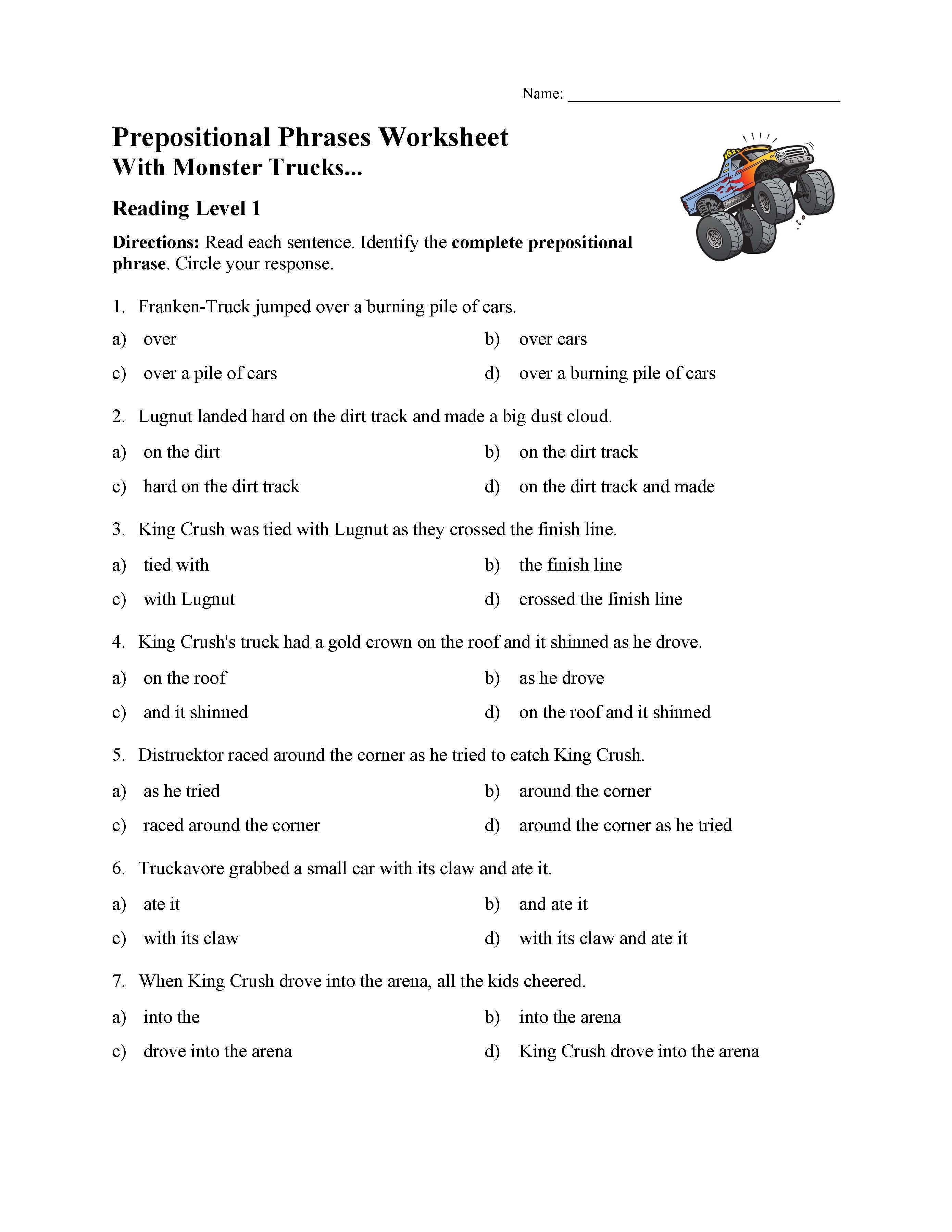
What Exactly Are Prepositional Phrases?
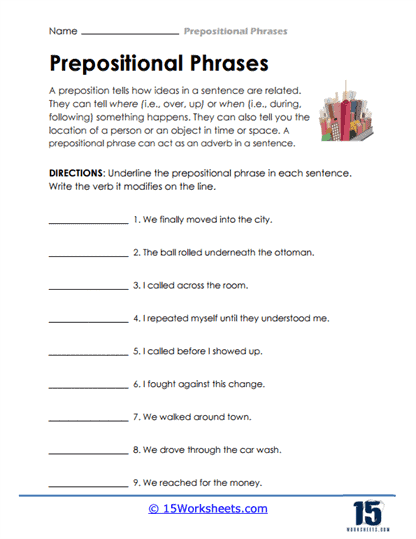
At its core, a prepositional phrase is a group of words that begins with a preposition and ends with a noun or pronoun, called the object of the preposition. It often includes modifiers (adjectives or adverbs) that describe the object.

Structure: Preposition + (Optional Modifiers) + Object of the Preposition
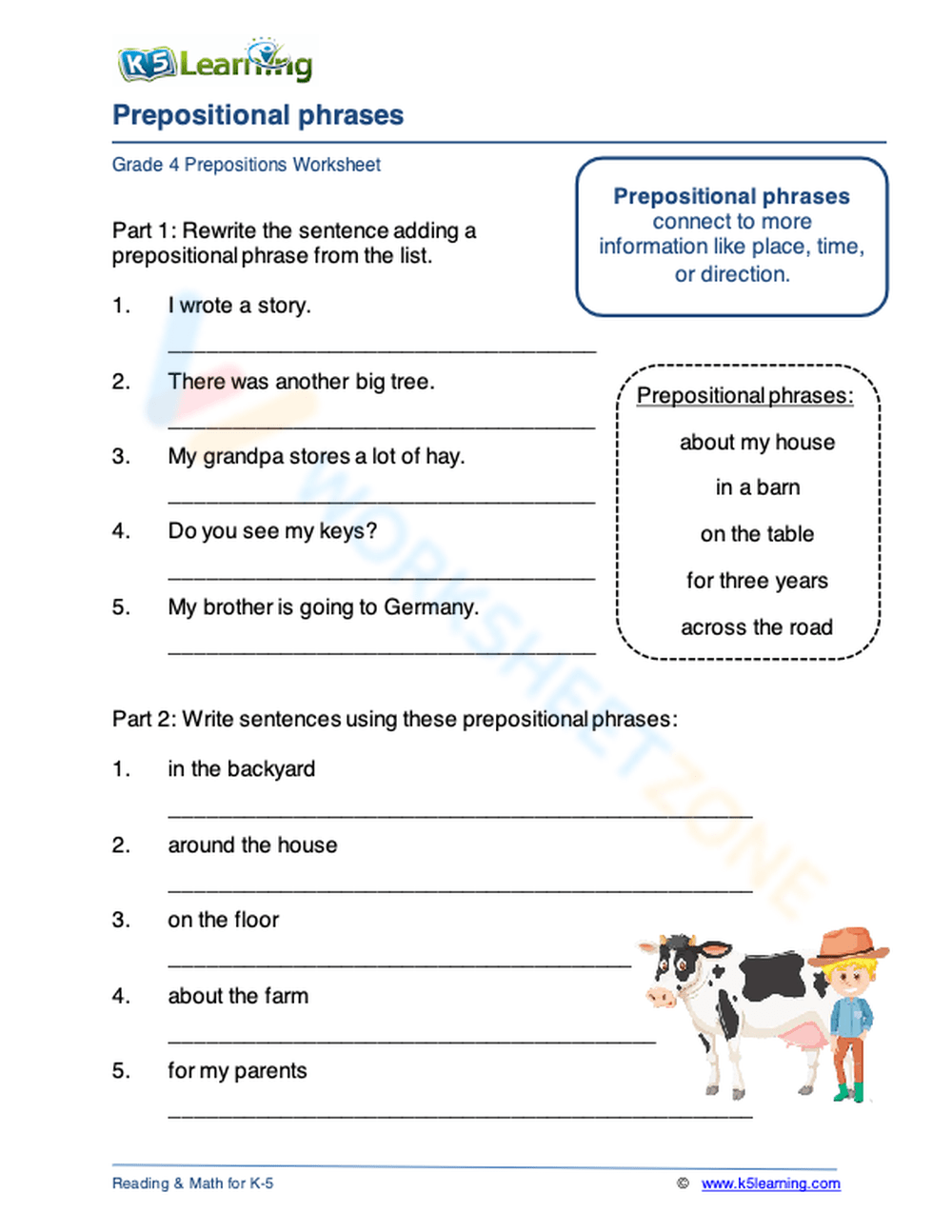
Examples:

- on the table (Preposition: on, Object: table)
- under the old, dusty blanket (Preposition: under, Modifiers: old, dusty, Object: blanket)
- with great enthusiasm (Preposition: with, Modifier: great, Object: enthusiasm)
- during the quiet night (Preposition: during, Modifier: quiet, Object: night)
- by him (Preposition: by, Object: him – a pronoun)

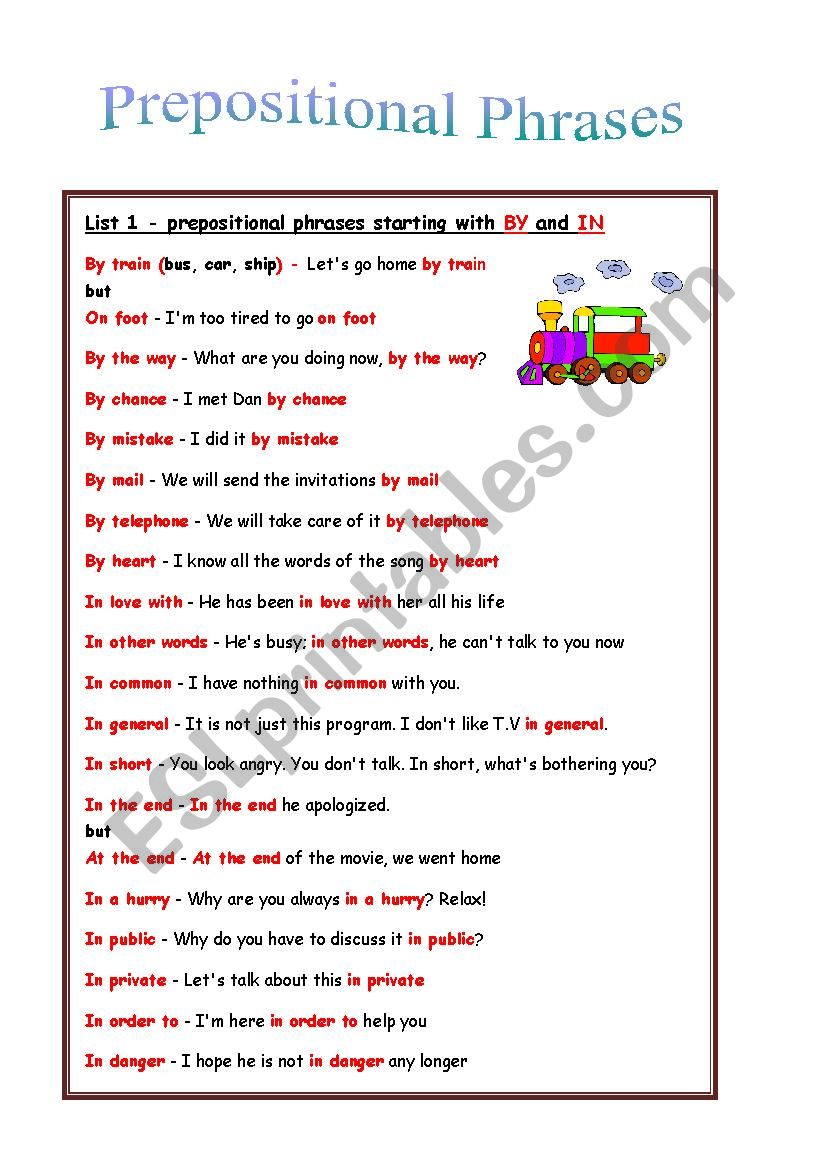
Prepositional phrases typically function as either adjectives or adverbs:
- Adjectival Phrases: They modify a noun or pronoun, answering questions like "which one?" or "what kind?".
- The book on the shelf is mine. ("on the shelf" describes "book")
- Adverbial Phrases: They modify a verb, adjective, or another adverb, answering questions like "when?", "where?", "how?", or "why?".
- She walked to the store. ("to the store" describes where she walked)
- He spoke with confidence. ("with confidence" describes how he spoke)
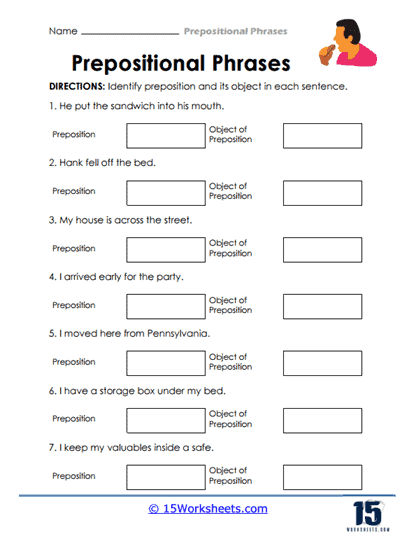
Understanding this fundamental structure and function is the first step towards mastering prepositional phrases, and it’s precisely what well-designed Prepositional phrases worksheets aim to solidify.
The Indispensable Role of Prepositional Phrases in Language
Prepositional phrases are not just grammatical niceties; they are essential for effective communication. They add detail, context, and precision to sentences, transforming basic statements into rich and informative expressions.
Consider the sentence: "The cat slept."
This is simple, but lacks detail.
Now, add prepositional phrases: "The cat slept under the warm blanket on the soft couch during the afternoon."
Each phrase adds vital information: where, what kind, and when. Without them, our language would be remarkably bland and ambiguous. They allow us to specify location, time, manner, purpose, and much more, making our writing and speaking more vivid and precise.
Why Prepositional Phrases Worksheets Are Essential Learning Tools
Given their importance, dedicated practice is key to mastering prepositional phrases. This is where Prepositional phrases worksheets prove their value. They provide a structured, repetitive, and often varied approach to learning that goes beyond simple explanations in a textbook.
Here’s why they are so essential:
- Targeted Practice: Worksheets focus specifically on prepositional phrases, allowing learners to concentrate their efforts without being distracted by other grammatical concepts.
- Reinforcement: Repetition through various exercises helps solidify understanding and recall, moving knowledge from short-term to long-term memory.
- Identification Skills: Many worksheets specifically train students to identify the preposition and its object within a sentence, a crucial first step.
- Application in Context: Beyond identification, worksheets often require students to use prepositional phrases correctly in their own sentences, applying what they’ve learned.
- Error Correction: By encountering common mistakes and practicing correcting them, students develop a keen eye for grammatical accuracy.
- Self-Assessment: Most worksheets come with answer keys, allowing students to check their work independently, identify areas of weakness, and track their progress.
Types of Prepositional Phrases Worksheets and Their Benefits
The best Prepositional phrases worksheets offer a variety of exercise types to cater to different learning styles and reinforce various aspects of understanding.
-
Identification Worksheets:
- Activity: Students are given sentences and asked to underline or highlight the prepositional phrases. Some might ask to circle the preposition and box the object.
- Benefit: Develops the foundational skill of recognizing the structure of a prepositional phrase within a sentence.
-
Sentence Completion Worksheets:
- Activity: Sentences have blanks where students must insert an appropriate prepositional phrase. Sometimes a word bank of prepositions or phrases is provided.
- Benefit: Encourages understanding of context and the appropriate use of prepositions to convey meaning. It helps with vocabulary and idiomatic expressions involving prepositions.
-
Combining Sentences Worksheets:
- Activity: Students are given two simple sentences and asked to combine them into one more complex sentence using a prepositional phrase.
- Benefit: Improves sentence fluency, reduces choppiness, and teaches students how to embed descriptive detail efficiently.
-
Error Correction Worksheets:
- Activity: Sentences contain incorrect or awkwardly placed prepositional phrases, and students must identify and correct them.
- Benefit: Sharpens critical thinking skills and helps students avoid common grammatical errors in their own writing. It builds an awareness of common prepositional errors (e.g., using "in" instead of "on" for a specific surface).
-
Function Identification Worksheets (Adjectival vs. Adverbial):
- Activity: Students identify prepositional phrases and then determine if they are functioning as an adjective or an adverb, often stating what word they modify.
- Benefit: Deepens understanding of the grammatical role of these phrases and how they contribute to sentence meaning. This is crucial for advanced sentence analysis.
-
Creative Writing Prompts with Prepositional Phrases:
- Activity: Students are given a topic or a starting sentence and instructed to write a short paragraph or story incorporating a minimum number of prepositional phrases.
- Benefit: Encourages active application of the learned concepts in a creative context, making the learning more engaging and demonstrating practical utility.
-
Matching Worksheets:
- Activity: Students match prepositions to their common objects or match parts of phrases to complete them.
- Benefit: Good for beginners to associate prepositions with their typical usage and build foundational knowledge.
Designing and Selecting Effective Prepositional Phrases Worksheets
For educators and self-learners alike, choosing or creating effective Prepositional phrases worksheets is paramount. Look for or incorporate the following features:
- Clear Instructions: Ambiguous instructions lead to confusion and frustration.
- Varied Exercise Types: As discussed above, a mix keeps students engaged and addresses different learning aspects.
- Gradual Difficulty: Start with simple identification and progress to more complex application and error correction.
- Relevant Examples: Use sentences that are relatable and interesting to the target audience.
- Answer Keys: Essential for self-correction and feedback.
- Engaging Content: While grammar can be dry, worksheets can be made more interesting with themes, relatable scenarios, or even humor.
Integrating Worksheets into the Curriculum
Prepositional phrases worksheets can be seamlessly integrated into various teaching and learning scenarios:
- Classroom Activities: Use them for individual practice, pair work, or small group challenges. They can be a great way to start a lesson (review) or conclude one (assessment of understanding).
- Homework Assignments: Reinforce classroom learning and provide independent practice.
- Assessment Tools: Quickly gauge students’ understanding of prepositional phrases.
- Differentiation: Provide simpler worksheets for struggling learners and more challenging ones for advanced students.
- Review Sessions: Before tests or exams, worksheets offer a quick and effective way to revisit concepts.
Maximizing Learning with Prepositional Phrases Worksheets: Tips for Students
For students using Prepositional phrases worksheets, here are some tips to get the most out of them:
- Understand the Basics First: Before diving into complex exercises, ensure you understand what a preposition is and what an object of the preposition is.
- Read Instructions Carefully: Don’t rush into exercises without fully understanding what’s being asked.
- Don’t Just Guess: If you’re unsure, try to reason through it or consult a grammar guide. Blind guessing doesn’t lead to learning.
- Review Your Answers: Use the answer key not just to see if you were right or wrong, but to understand why an answer is correct. Analyze your mistakes.
- Seek Clarification: If you consistently make the same error or don’t understand an explanation, ask your teacher or a knowledgeable peer for help.
- Practice Regularly: Short, consistent practice sessions are more effective than infrequent, long ones.
Common Challenges and How Worksheets Address Them
Students often struggle with:
- Identifying the entire phrase: Sometimes they only pick out the preposition or include too many words. Worksheets with clear boundary identification tasks help.
- Distinguishing between prepositional phrases and other grammatical structures: For example, differentiating between a preposition and an adverb (e.g., "She ran down the hill" vs. "He sat down"). Targeted worksheets can highlight these distinctions.
- Choosing the correct preposition: English has many idiomatic uses of prepositions (e.g., "on time" vs. "in time"). Sentence completion and error correction exercises specifically target these nuances.
- Using them effectively in writing: Moving from identification to application. Creative writing prompts and sentence combining exercises bridge this gap.
Finding Quality Prepositional Phrases Worksheets
The good news is that high-quality Prepositional phrases worksheets are readily available. You can find them:
- Online Educational Platforms: Websites like Teachers Pay Teachers, Education.com, K5 Learning, and various university writing center sites offer free and paid resources.
- Textbooks and Workbooks: Most grammar textbooks include dedicated sections and exercises.
- Teacher-Created Resources: Many educators share their self-made materials online.
- Printable Sites: Numerous websites specialize in printable grammar worksheets for all levels.
Conclusion
Prepositional phrases are indispensable components of the English language, adding richness, precision, and clarity to our communication. Mastering their use is a significant step towards achieving grammatical fluency and becoming a more effective communicator. Prepositional phrases worksheets are not just supplementary materials; they are fundamental tools that provide the necessary structured practice, reinforcement, and application opportunities for learners of all levels. By consistently engaging with varied and well-designed Prepositional phrases worksheets, students can transform their understanding from abstract concepts into confident, practical language skills, ultimately leading to clearer, more sophisticated writing and speaking. Embrace these valuable resources, and unlock the power of precise language.

